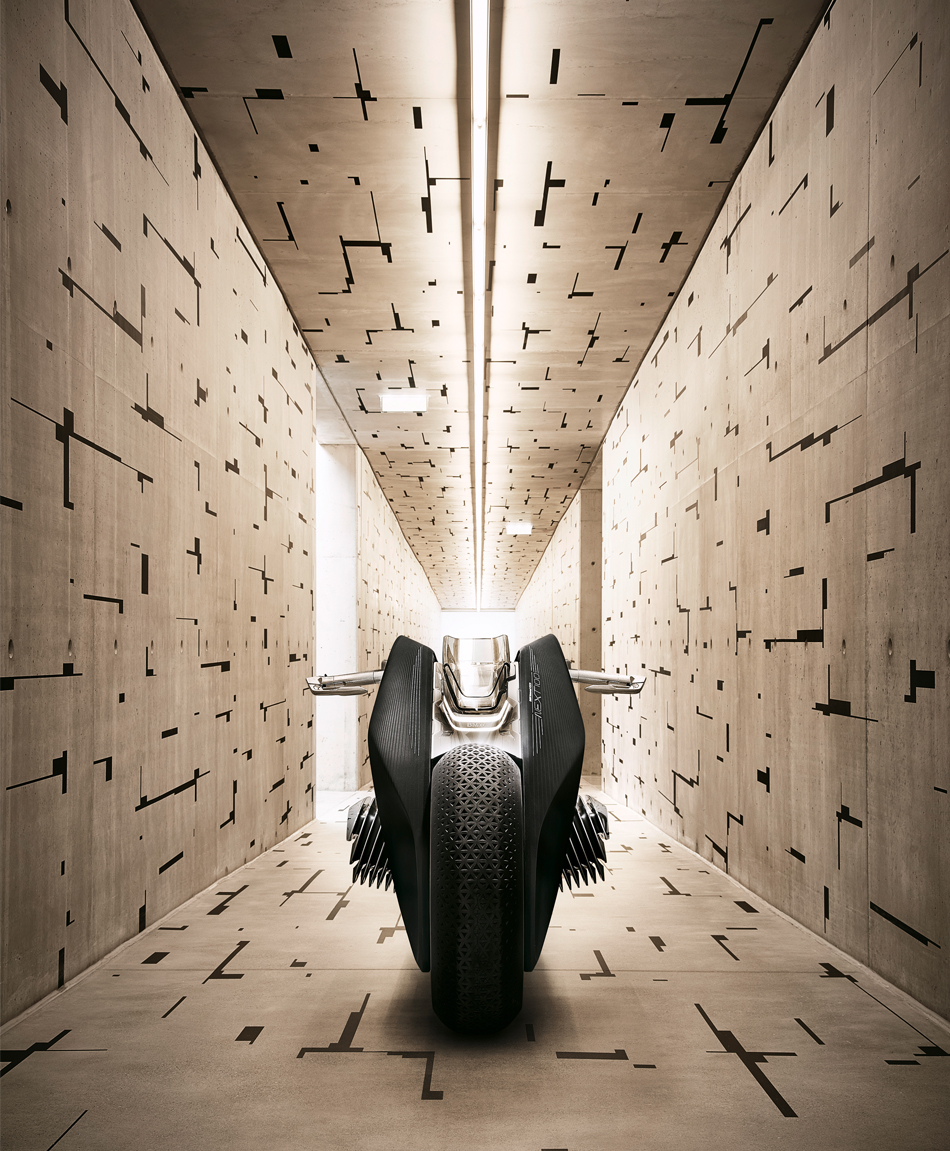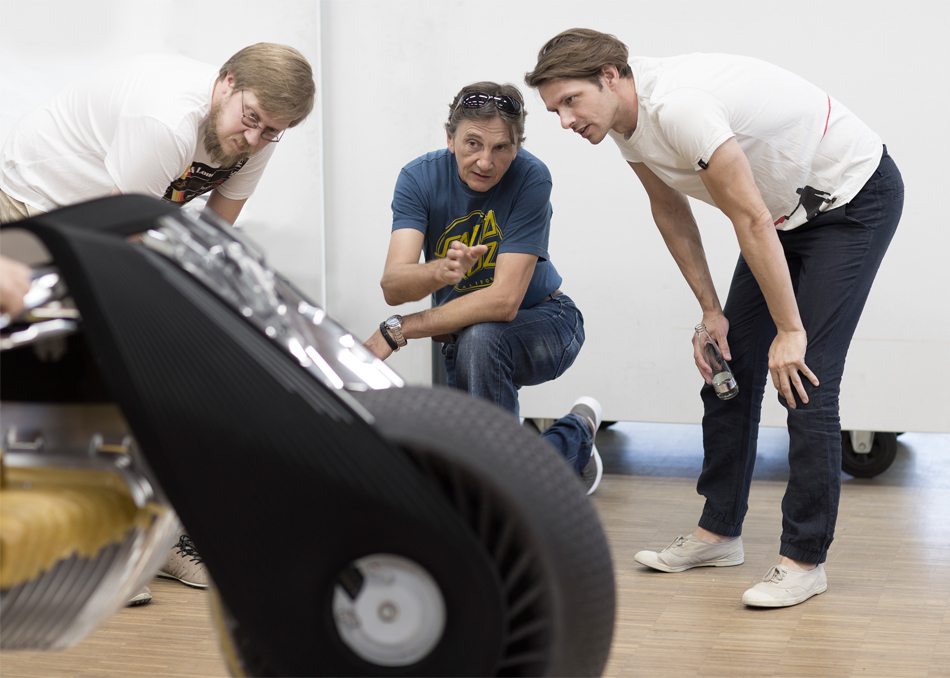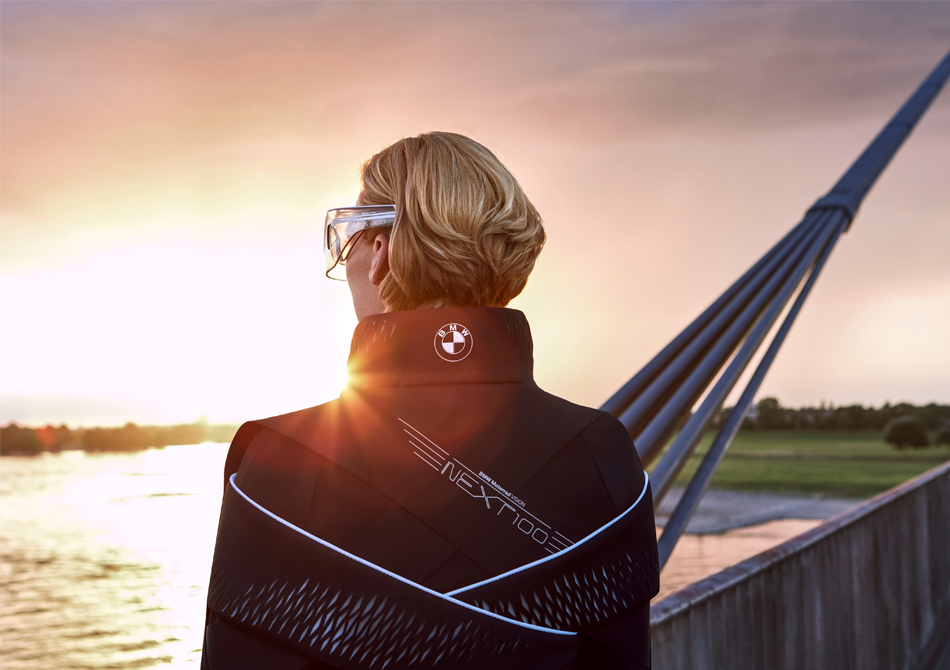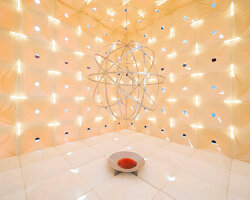labelled as the ‘great escape’, the BMW VISION NEXT 100 motorcycle creates a pure and unrestricted rider experience. designboom was at the official unveiling of the concept in LA, which concluded the german automotive brand’s centenary celebrations after the previous launches of the BMW, MINI and rolls-royce visions. like these concepts, the motorbike similarly uses an autonomous driving system but primarily employs the technology for safety. this ensures that the user has a raw, sensory ride, one which highlights the uniqueness of motorcycling.

the motorrad concept finalizes BMW’s 100-year festivities exactly how the company first started – with a motorbike
at the exclusive launch of the BMW VISION NEXT 100 motorcycle, designboom sat down with the head of BMW motorrad design edgar heinrich, and the designer responsible for the new visionary driver equipment friederike richter. here, we discussed the design processes behind the concept bike and its companioning clothing, their use of innovative and connected technology systems, and how the motorcycle’s safety features may lead to the redundancy of driving licenses in the future.
designboom (DB): which of the various technologies on the BMW motorrad VISION NEXT 100 bike that we do not already have, do you think will be the first for us to get?
edgar heinrich (EH): I think there are several things that are really just round the corner. firstly, the connectivity could be introduced soon. it could be called smart gear and would provide more information to the rider for safety reasons for example. this could be seen in production very soon as we already have it in cars. the technology is already out there but we just have to recombine it in a good way for motorbikes.

it features a nostalgic black triangle frame
DB: can you talk more about the concept’s use of materials, specifically about its use of carbon fiber?
EH: this carbon fiber subject is very interesting. getting more carbon fiber into a bike is a very interesting issue. by replacing other materials with it, weight problems are improved, and so are carbon emissions and packaging difficulties. there is not so much carbon fiber on standard motorbikes, instead you might have it on after-market ones. people spend a lot of money for carbon fiber, just to make it lighter. here, we have unusual components in carbon fiber like frames or wheels, which is not very far away from being realized.
DB: what other new materials are you working with or planning to work with in the future beside carbon fiber?
EH: there are a few things coming. there is one division in the company which is constantly developing on new ideas, technologies and also materials. we have a department like this in motorrad but it is more focused on engineering. we also have a team which is always searching and analyzing future trends, and extracting what could be really interesting for bikes. this is a normal, on-going process within the company.

head of BMW motorrad design edgar heinrich standing behind the concept motorbike
image © designboom
DB: how long did it take to create the bike, from when you first got the assignment to this final point?
EH: for this actual model, it probably took over a year. there were obviously sketches earlier than this so really, we first started this 18 months ago. there were lots of obstacle to overcome first so it wasn’t so easily.
DB: can you talk a little bit more about the design process, specifically the idealization stages and how it was narrowed down to the final concept?
EH: at the beginning, we had the BMW group vision. initially, we sat together under the BMW roof, but soon after, every brand did its own extraction of the vision. every marque tried to target specific requirements and needs for the user. for us, the process started nearly two years ago with sketches. we sat down together, everyone had lots of ideas, and some were really weird. after this, we tried to funnel it all into a focused concept.

the zero-emissions engine moves for aerodynamic and safety purposes
image © designboom
DB: the headset instrument is a major part of the bike, is there something like this that exists at the moment or is it a distant concept?
EH: well heads-up-displays (HUD), which uses augmented technology, already exist in jet planes or in cars, and so does the google glass. the technology is possible and close to realization, but it needs to be directed in the right way. the basic idea was that we wanted to remove all these user interfaces because at the moment, riders look too much at them and also at the bike’s gauges. users want to look at the road and scan the environment. the idea behind the concept was that it should be more like horse-riding, it should feel really free, where you are not being controlled by the interfaces. it should be the other way around, I want to control it, and if I am looking around and there is a risky situation coming up, the bike should know it. if I am not reacting in time, the bike will sort it all out safely.
DB: in regards to the added safety features and how it detects and solves potential hazards, do you think this technology will lead to potentially worse and empty-minded drivers?
EH: that is a very good question. going back to the beginning of this project, we were looking at 30 years from now. so, what is in 30 years time? we have autonomous cars everywhere as this will be an industry standard, and safety will only be improved because of this. our job is to make a cool motorbike in this environment. for example, my designers would want a cool bike, where they don’t have to deal with all the safety features because they do not need it. they want to be free. I can tell you that 30 years from now, you can have an absolutely analogue riding experience by using the bike without the helmet and the rider gear. everyone will be able do it – even a beginner. on the other hand with the gyro technology, you as an experienced rider, can have even more fun as the advancement will actively boost you.

the motorbike has a dynamic sculptural flexframe
image © designboom
DB: in the eyes of experience motorcyclists, would the additional technologies actually cause a negative riding experience or, do you believe that with the gyro technology riders will actually have more fun?
EH: it is hard to imagine but it is true. I am experienced and I say that I do not need this stuff. however, a few years ago we launched the GS motorrad, which introduced the then new ASC (automatic stability control) technology, and showed the world that you could accelerate into corners on gravel like crazy. you could drift and brake at high speeds in gravel. I would have never done this without the system. I would never have believed this until I tried it. my experience tells me that there are still things that need to be improved, and this bike tries to show some of these possibilities.
DB: we have been talking about the motorcycle of 100 years, but we are actually talking about this being 30 years away, why is this?
EH: this was our take on the vision. the message of the next 100 years is to commemorate BMW’s centenary celebrations. however, it wouldn’t be serious if we were to try and predict 100 years in the future, it is difficult enough trying to predict 10 years in the future!
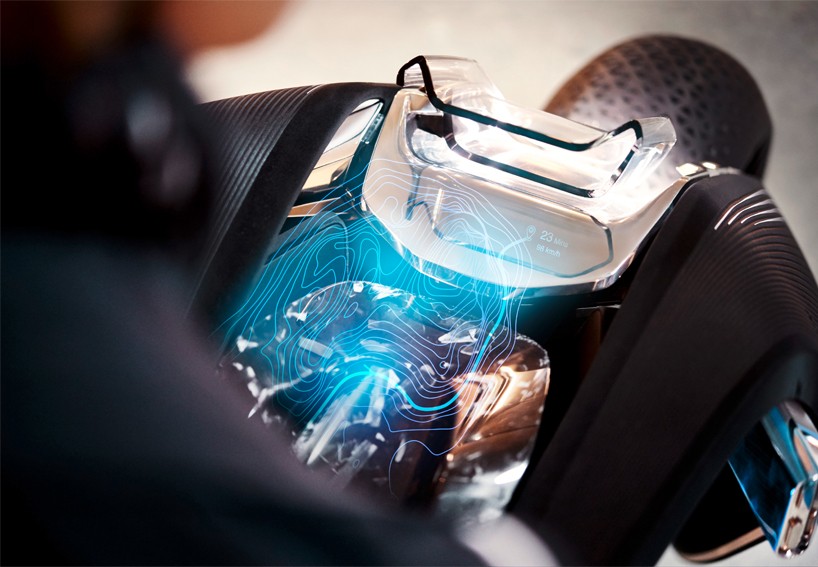
the navigation map connects to the user’s headset and their suit
DB: how did your designers get an understanding for this future environment?
EH: with my team of designers, you don’t really need to push them to look towards the future. they do this every day anyways. they come up with some weird ideas on a daily basis. this shows a lot of creative energy and we are just focusing this on a project like the concept here. my designers are really eccentric, every day for 15 years they have come up with crazy ideas. they already know what technology trends and potentials are already available or being developed, but we have to direct this towards one design.
DB: do you see a day in 30 years when you will not need to have a driving license?
EH: this is a very good question. basically, the way I see it, you would be able to get a license but then you would have to prove on the bike that you can handle that level. the motorcycle could actually control levels of difficulty. when the rider is good enough, they could then access the next level of power for example.

the new driver equipment reflects its freedom from the design need for safety
also at the exclusive los angeles launch, we spoke with friederike richter, the designer responsible for the new visionary driver equipment, to discuss her background and how she first got started at BMW motorrad. furthermore, we delved into the design process behind the clothes, the impact of removing safety as the equipment’s main function, and also the wearable technology which is embedded within the fabric.
DB: could you briefly tell us about your background, how you first got involved with BMW motorrad, and how your work has evolved over the years?
friederike richter (FR): I studied fashion design and completed my degree in 2012. after that I worked as a designer at a small company in vienna, which focused on menswear and then later womenswear. after that I went to hugo boss, so I really had a fashion background, rather than one on motorbike design. however, I have always been interested in functional materials and their developments. it is very interesting and it was an importance that stuck with me. I’m actually not a motorcyle rider but I got this job and have been working for BMW motorrad for three years. for this project, I have been working on the BMW motorrad ‘VISION NEXT 100’ gear for the last year.

the unexpected clothing is a fashion statement that mixes style and innovative technology
DB: can you talk more about the design process behind the new driver equipment and whether you were working in close collaboration with motorrad vehicle designers?
FR: it was really cool. we had this freedom for designing. the design process was really different to what we normally do. usually, we have the suit, and we already know what its function is and what the target market is. this can be very limiting as it has to be a jacket or trouser or suit, but this was very different. we could do absolutely anything. this was really interesting and fun. I started working in three-dimension, working with paper and other different materials. we worked closely with the actually vehicle design so ideas were bouncing off one another as it was a collaborative process. normally, they do the vehicles and I do the suits. we kind of work together but not that closely. this was different and inspiring. you can see this from the outcome – it is very unexpected. it is much more of a fashion statement than our previous work. it is a suit that you can wear at a party or at a cafe, and you don’t look like just a motorbike rider. it is cool, easy and light.
DB: with this new freedom, did you actually start off by creating too unusual and extreme clothing ideas, and was the final piece the result of a more realistic approach?
FR: yes, at one point I was wondering whether anyone would actually understand the whole idea behind the design. at the beginning, I didn’t really know if it was a suit, jacket or dress. however at one point, it got really focused and so I then knew that it was going to be jacket for example. for me, that felt better because then I knew that it wasn’t just something weird in my head. I always want to do clothes that people wear and not just mannequins in my design studio.

the visor is a key part of connection between the suit and the motorcycle
DB: how is this concept driver equipment now influencing the clothing for future BMW driving gear or is will this be left as just a conceptual idea?
FR: it will definitely not be hidden away – it will be the inspiration! I hope we can have a model standing in the middle of our studio so that we can see it every day. it is really our vision and we will definitely shape our work accordingly. the vision will continue, it is not the case to just present it here. it is our direction, we are showing you where we want to go and this is just the beginning.
DB: how has new technology influenced the shaping and features of this design?
FR: there are lots of different features in the suits, such as the whole body sensors that measure the rider’s pulse, heart beat and body temperate, and they can actually give you a comforting feeling. there are openings on the chest and collar which shift for ventilation. everything is connected so the sensors can actually signal to the material to open. there are flexible band structures that can support you. this means that if the rider feels tired, the bands react and help you. there is also an integrated navigation system in the suit, which uses vibrating pads to direct the driver. the bike actually has the map so in this instance, the suit is connected to the motorcycle. this connection between the two is managed and facilitated via the headset visor.

designer friederike richter trying on parts of the suit





